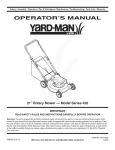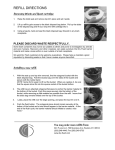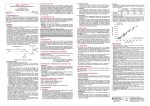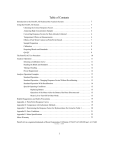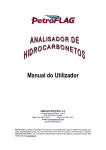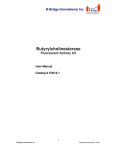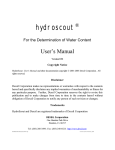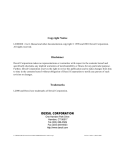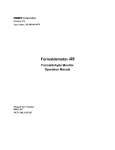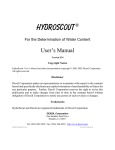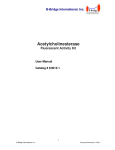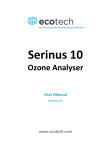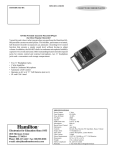Download U.S. EPA SW-846 Draft Method 9074 (DMR-17-01)
Transcript
METHOD 9074 TURBIDIMETRIC SCREENING METHOD FOR TOTAL RECOVERABLE PETROLEUM HYDROCARBONS IN SOIL 1.0 SCOPE AND APPLICATION 1.1 This method may be used to screen soil samples to determine the total amount of recoverable petroleum hydrocarbon contamination in soil including a wide range of fuels, oils, and greases. The turbidimetric approach in this method is designed to quickly screen soil samples using a system calibrated with a blank and a single calibration standard. 1.2 The definition of total recoverable petroleum hydrocarbons for this method can be found in the section on definitions (Sec. 3.0). 1.3 This screening technique is specifically designed to be used in the field but may also have some screening applications in the laboratory. The system analysis range is 10-2000 ppm for most hydrocarbons. 1.4 This method is considered a screening technique because of the broad spectrum of hydrocarbons it detects. The method may be especially useful in quickly determining that a site does not contain hydrocarbon contamination. However, it cannot be used to determine specific hydrocarbon compounds or groups of compounds that may be part of a larger hydrocarbon mixture. As with other screening techniques, it is advisable to confirm a certain percentage of both positive and negative test results, especially when near or above a regulatory action limit or when the presence of background or interfering hydrocarbons is suspected. The limitations of this procedure are described in more detail in the section on interferences (Sec. 4.0). 1.5 This method does not address the evaporation of volatile petroleum hydrocarbon mixtures (i.e. gasoline) during sample collection, preparation, and analysis. Although the screening kit can be used to qualitatively detect volatile hydrocarbons, it is NOT recommended that the system be used to quantitatively determine volatile petroleum hydrocarbons unless evaporation during sample handling is addressed, appropriate response factor corrections are made, and method performance is demonstrated on real world samples. 1.6 This method is restricted to use by or under the supervision of trained analysts. Each analyst must demonstrate the ability to generate acceptable results with this method. 2.0 SUMMARY OF METHOD 2.1 A 10 ± 0.1 g sample of soil is extracted with a solvent mixture composed primarily of methanol. The resulting mixture is allowed to settle and the free liquid is decanted into the barrel of a filter-syringe assembly. The liquid is filtered through a 0.2-µm filter into a vial containing an aqueous emulsifier development solution. The filtered sample is allowed to develop for 10 minutes. During the development, any hydrocarbons present precipitate out and become suspended in solution. 2.2 The developed sample is placed in a turbidimeter that has been calibrated using a blank and a single calibration standard. A beam of yellow light at 585 nm is passed through the CD-ROM 9074 - 1 Revision 0 January 1998 sample and the scattering of light through the suspension at 90° is measured. The concentration of total recoverable petroleum hydrocarbons present is calculated relative to the standard curve. 3.0 DEFINITIONS 3.1 See Sec. 5.0 of Chapter 1 and the manufacturer’s instructions for definitions associated with this analytical procedure. 3.2 For the purpose of this method, “total recoverable petroleum hydrocarbons” is defined as those hydrocarbons that are recovered using the solvent-specific extraction procedure provided with this kit. Since there is no cleanup step to separate any co-extracted naturally occurring hydrocarbons from the petroleum hydrocarbons, elevated turbidimetric readings are likely without performing background correction. See the interferences section (Sec. 4.0) for additional details. 4.0 INTERFERENCES 4.1 This method is considered a screening technique because of the broad spectrum of hydrocarbons it detects. It cannot distinguish between co-extracted naturally occurring hydrocarbons and petroleum hydrocarbons. Using background correction and/or a selected response factor discussed in the manufacturer’s instructions, an analyst may be able to eliminate some of the interferences caused by co-extracted naturally occurring hydrocarbons. However, it is very difficult to find a truly clean, representative sample for use as a background. 4.2 This method has been shown to be susceptible to interference from vegetable oils (positive interference). It is anticipated that co-extracted naturally occurring oils from vegetative materials would be one of the most probable positive interferants found in the field. To demonstrate this interference, standard soil samples were spiked with corn oil at levels of 50 to 1000 ppm and tested with PetroFLAGTM system. Soil samples spiked with mineral oil were also analyzed for comparison. These data indicate that, over the range tested, the slope of the PetroFLAG™ vegetable oil response is approximately 18% of the response of the mineral oil standard. Supporting data are presented in Table 2. 4.3 This method has been shown to be susceptible to interference from water (negative interference). To demonstrate this interference, soils were spiked with diesel fuel at 100 ppm. The samples were then spiked with varying amounts of water, up to saturation. The samples were analyzed using the PetroFLAG™ system and the results were below that expected for the spike added. The low bias may be due to a decrease in extraction efficiency in samples containing large amounts of water, as a result of dilution of the extraction solvent. Supporting data are presented in Table 3. 4.4 This method has been shown to NOT be significantly affected by up to 5% sodium chloride contamination. Supporting data are presented in Table 6. 4.5 This method has been shown to NOT be significantly affected by up to 1000 ppm of common surfactants such as trisodium phosphate (TSP), soap, and sodium dodecyl sulfate (SDS). Supporting data are presented in Tables 7, 8, and 9. 4.6 Polycyclic aromatic hydrocarbons (PAHs) are a class of compounds present in many hydrocarbon mixtures that are detected by the PetroFLAG system. These compounds are often targeted because of their toxic characteristics and may be present individually as soil contaminants. CD-ROM 9074 - 2 Revision 0 January 1998 However, the response of the individual PAHs varies greatly from compound to compound. Therefore, use of the PetroFLAG system to quantitate individual PAHs is not recommended without good knowledge of the site and after adjusting the analytical approach. Quantitation of PAHs as part of a larger hydrocarbon fraction, such as diesel fuel, is recommended. Supporting data are presented in Table 12. 4.7 The PetroFLAG™ analyzer can be used at temperatures from 4°C to 45°C. The analyzer is equipped with an on-board temperature sensor to measure the ambient temperature at which measurements are being made. The software uses this temperature reading to correct the optical drift caused by temperature fluctuations. 4.8 Temperature at which the calibration is run should be recorded because of the effect temperature has on the suspension. This can be done by taking a reading without inserting a vial. If, during sample analysis, the temperature fluctuates more than ±10°C from the temperature at the calibration, the calibration should be rerun at the new temperature. 5.0 SAFETY Safety practices appropriate for handling potentially contaminated hazardous or toxic samples and extraction solvents should be employed. 6.0 EQUIPMENT AND SUPPLIES PetroFLAGTM Hydrocarbon Analysis System, (Dexsil Corporation, One Hamden Park Drive, Hamden, CT), or equivalent. Each commercially-available test kit will supply or specify the apparatus and materials necessary for successful completion of the test. 7.0 REAGENTS AND STANDARDS Each commercially-available test kit will supply or specify the reagents necessary for successful completion of the test. Reagents should be labeled with appropriate expiration dates, and reagents should not be employed beyond such dates. 8.0 SAMPLE COLLECTION, PRESERVATION, AND STORAGE 8.1 See the introductory material to this chapter, Organic Analytes, Sec. 4.1. 8.2 Soil samples may be contaminated, and should therefore be considered hazardous and handled accordingly. All samples should be collected using a sampling plan that addresses the considerations discussed in Chapter Nine. 8.3 To achieve accurate analyses, soil samples should be well homogenized prior to testing. The hydrocarbons may not be evenly distributed in a soil sample and extensive mixing is necessary to assure homogeneity. NOTE: CD-ROM It is strongly recommended that any free aqueous liquid be decanted from samples prior to analysis with the PetroFLAG system. Free aqueous liquid will dilute the extraction solvent and produce a negative interference. 9074 - 3 Revision 0 January 1998 NOTE: 9.0 When users of the PetroFLAG system wish to report their results on a dry weight basis, additional representative samples should be collected for percent moisture determination. See the extraction Methods 3540 or 3550 for the procedure for determining percent moisture. QUALITY CONTROL 9.1 Follow the manufacturer's instructions for quality control procedures specific to the test kit used. Additional guidance on quality control is provided in Chapter One. 9.2 Use of replicate analyses, particularly when results indicate concentrations near the action level, is recommended to refine information gathered with the kit. 9.3 Method 9074 is intended for use as a screening procedure in either the field or a fixed laboratory. Wherever it is employed, a quality assurance program appropriate for a screening procedure should be employed as a means of documenting the quality of the resulting data. 10.0 CALIBRATION AND STANDARDIZATION See the PetroFLAGTM Hydrocarbon Analyzer User’s Manual for instruction on generating an initial calibration curve using the PetroFLAG™ analyzer. Contact the manufacturer for specific details on the calibration calculations programmed into the PetroFLAG™ analyzer. 11.0 PROCEDURE Follow the manufacturer's instructions in the PetroFLAGTM Hydrocarbon Analyzer User’s Manual to extract, develop, and analyze soil samples. Those test kits used must meet or exceed the performance specifications indicated in Tables 1 through 3. 12.0 DATA ANALYSIS AND CALCULATIONS Consult the PetroFLAGTM Hydrocarbon Analyzer User’s Manual for the procedure used to generate concentration readings from samples using the PetroFLAG™ analyzer. Contact the manufacturer for specific details on the concentration calculations programmed into the PetroFLAG™ analyzer. 13.0 METHOD PERFORMANCE 13.1 Method Detection Limits were determined using a modification of the procedures in Chapter One and in 40 CFR, Part 136. The procedure was modified slightly because the instrument automatically subtracts an average blank value for each analysis (blank analysis is part of the calibration procedure of the PetroFLAG™ test system). Two sets of seven samples each were prepared, one set spiked with 30 ppm of diesel fuel, and one set spiked with 30 ppm of used motor oil. The standard deviation (SD) of the results for each oil type were calculated. The method detection limit (MDL) was determined by multiplying the SD by the Student's t value (3.143). These data are presented in Table 1. The MDL for diesel fuel was 13 ppm and for used motor oil was 18.6 ppm (Ref 1). CD-ROM 9074 - 4 Revision 0 January 1998 13.2 Samples of a standard soil were prepared by spiking with either diesel fuel or used motor oil at 100 ppm intervals from 100 ppm to 1000 ppm. Each sample was analyzed in duplicate by the PetroFLAG™ system and by Methods 3550 and 8015B. The results are shown in Table 4. These data were analyzed using regression analysis. The results of the regression analysis are also provided in Table 4. In addition, an analysis of variance (ANOVA) analysis was performed. The Fstatistic from the ANOVA revealed a significant bias between the two methods, with the PetroFLAG™ providing consistently higher values for both types of contamination. The results confirm that the kit design is intentionally conservative, in that it favors a high bias in order to avoid reporting false negative results (Ref. 1). 13.3 Precision and bias were determined by analysis of variance (ANOVA) of the results obtained from spiked soil samples. Four sets of spiked samples were prepared, containing either diesel fuel or used motor oil at two different concentrations (200 and 1000 ppm). Each analyte at each concentration was analyzed in duplicate 10 times (e.g., 20 replicates of each). The results were transformed into recovery data. The ANOVA used these transformed data. The results are presented in Table 5. The F-statistic for the diesel fuel analysis indicate a slight day effect for these samples. The F-statistic seems to be driven more by the very low value of the mean square error within days rather than by any large value for the mean square error between days (Ref. 1). 13.4 The response of the PetroFLAG System to a soil spiked with 500 ppm of diesel fuel and 0 to 5% of dry sodium chloride is provided in Table 6 (Ref. 2). 13.5 The responses of the PetroFLAG System to a soil spiked with 500 ppm of diesel fuel and up to 1000 ppm of common surfactants such as trisodium phosphate (TSP), soap, and sodium dodecyl sulfate (SDS), are presented in Tables 7, 8, and 9 (Ref. 2). 13.6 Performance of the PetroFLAG™ system on anthracene from 100 to 2000 ppm and on creosote from 100 to 1000 ppm are presented in Tables 10 and 11, respectively. An explanation of the erratic performance of anthracene is provided in the Table 10 narrative (Ref. 2). 13.7 The performance of the PetroFLAG system for several PAHs relative to the mineral oil calibrator on soil is presented in Table 12 (Ref. 4). 13.8 Performance of the PetroFLAG™ system on Jet-A from 40 to 2808 ppm (Ref. 4) and on gasoline from 1000 to 4070 ppm (Ref. 2) are provided in Tables 13 and 14, respectively. An explanation of the performance of Jet-A and gasoline are provided in the narrative in Tables 13 and 14. 14.0 POLLUTION PREVENTION This method does not use any halogenated solvents and may be used to help reduce the number of samples sent to the laboratory under certain project scenarios. Traditional laboratory extraction methods (i.e. Soxhlet or sonication) would generally require much larger volumes of solvent to extract the sample. 15.0 WASTE MANAGEMENT Waste management procedures must be consistent with federal, state, and local regulations. CD-ROM 9074 - 5 Revision 0 January 1998 16.0 REFERENCES 1. Data Validation Package, Testing for Petroleum Hydrocarbons in Soil by Turbimetric Analysis, PetroFLAG™ Test System, DEXSIL Corp., Hamden, CT. 2. Supplementary Validation Data, Additional Analyte and Contaminant Testing Data for the PetroFLAG™ Hydrocarbon Analysis System, DEXSIL Corp., Hamden, CT, August 24, 1995. 3. PetroFLAG™ Hydrocarbon Analyzer User’s Manual, DEXSIL Corp., Hamden, CT. 4. Supplementary Data Validation Package III, Additional Analyte Testing Data for Petroleum Hydrocarbons in Soil by Turbimetric Analysis - PetroFLAG™ Test System, DEXSIL Corp., Hamden, CT, June 20, 1997. 5. Supplementary Data Validation Package IV, Polycyclic Aromatic Hydrocarbon Response data for Method 9074 Petroleum Hydrocarbons in Soil by Turbimetric Analysis - PetroFLAG™ Test System, DEXSIL Corp., Hamden, CT, August 22, 1997. 17. TABLES, DIAGRAMS, FLOWCHARTS, AND VALIDATION DATA The pages to follow contain Tables 1 through 14. CD-ROM 9074 - 6 Revision 0 January 1998 TABLE 1 METHOD DETECTION LIMIT FOR PetroFLAG TEST SYSTEM Trial # 30 ppm diesel fuel 30 ppm motor oil 1 34 35 2 24 41 3 28 40 4 34 53 5 36 46 6 32 48 7 30 42 Average (ppm) 31.03 43.6 SD (ppm) 4.12 5.91 MDL (ppm) 13.0 18.6 Data from Reference 1. TABLE 2 RELATIVE RESPONSE OF VEGETABLE OILS AS AN INTERFERANT a Analyte Spike Concentration (ppm) Mineral Oil Response (ppm) Vegetable Oil Responsea (ppm) 50 55 30 100 100 45 200 189 94 500 504 111 1000 947 208 The vegetable oil samples were analyzed using the PetroFLAG system set to response factor 10. The slope of the PetroFLAG vegetable oil response is approximately 18% of the response of the mineral oil standard. This means that a sample containing 5,560 ppm vegetable oil would provoke a response equivalent to that given by 1,000 ppm mineral oil. Data from Reference 1. CD-ROM 9074 - 7 Revision 0 January 1998 TABLE 3 EFFECT OF WATER ON PetroFLAG RESULTS a CD-ROM a % Water Saturation (% Water) % Recovery of Mineral Oil 0 (0) 100 5 (1) 94 25 (5) 98 50 (10) 95 100 (20) 85 Soil sample spiked with 100 ppm of mineral oil. (Ref. 1) 9074 - 8 Revision 0 January 1998 TABLE 4 COMPARISON OF PetroFLAG AND GC TEST RESULTS Spike Conc. (µg/g) PetroFLAG (µg/g) 3550/8015B (µg/g) Diesel Fuel Trial 1 Trial 2 Trial 1 Trial 2 100 200 300 400 500 600 700 800 900 1000 112 230 312 420 538 626 774 910 1091 1182 116 248 370 455 564 654 790 900 977 1062 73 158 242 299 342 460 509 612 678 646 82 156 218 275 344 439 494 607 614 649 Corr Coef Slope Intercept 0.999 1.126 -2.8 0.992 0.679 30.5 Motor Oil Trial 1 Trial 2 Trial 1 Trial 2 100 200 300 400 500 600 700 800 900 1000 121 243 381 428 531 654 717 880 931 1014 128 292 408 497 554 668 771 883 1052 1098 123 200 301 341 441 534 609 711 835 887 82 200 275 343 452 528 652 746 881 846 Corr Coef Slope Intercept 0.998 1.02 50.9 0.997 0.887 20.5 Data from Reference 1. CD-ROM 9074 - 9 Revision 0 January 1998 TABLE 5 ANOVA RESULTS FOR SPIKED PETROLEUM HYDROCARBON SAMPLES Analyte/Concentration n Diesel, 200 ppm Diesel, 1000 ppm Motor Oil, 200 ppm Motor Oil, 1000 ppm 20 20 20 20 Mean (0) 1.09 1.00 1.12 0.937 Variance (Fn-12) Standard Deviation (Fn-1) 0.0059 0.00430 0.00266 0.000919 Standard Error (F0) 0.0768 0.0656 0.0515 0.0303 0.0172 0.0147 0.0115 0.00678 Data from Reference 1. TABLE 6 RESPONSE OF PetroFLAG SYSTEM WITH VARIOUS LEVELS OF SODIUM CHLORIDEa % Sodium Chloride PetroFLAG Response (ppm) a 0 0.5 1.0 2.0 5.0 518 539 529 516 524 A series of soil samples consisting of sand, clay, and topsoil was spiked with 500 ppm of diesel fuel and varying levels of dry sodium chloride (NaCl) from 0 to 5 percent. The samples were analyzed using the PetroFLAG system set to response factor 5 (Ref. 2). TABLE 7 RESPONSE OF PetroFLAG SYSTEM WITH VARIOUS TSP CONCENTRATIONSa TSP Concentration (ppm) PetroFLAG Response (ppm) a 0 100 200 500 1000 522 511 512 500 492 Response of the PetroFLAG system for soil containing 500 ppm of diesel fuel and various levels of trisodium phosphate(TSP), a common surfactant. The samples were analyzed using the PetroFLAG system set to response factor 5 (Ref. 2). CD-ROM 9074 - 10 Revision 0 January 1998 TABLE 8 RESPONSE OF PetroFLAG SYSTEM WITH VARIOUS SOAP CONCENTRATIONSa Soap Concentration (ppm) PetroFLAG Response (ppm) a 0 100 200 500 1000 500 494 488 502 528 Response of the PetroFLAG system for soil containing 500 ppm of diesel fuel and various levels of soap (non-ionic and anionic surfactants). The samples were analyzed using the PetroFLAG system set to response factor 5 (Ref. 2). TABLE 9 RESPONSE OF PetroFLAG SYSTEM WITH VARIOUS SDS CONCENTRATIONSa SDS Concentration (ppm) PetroFLAG Response (ppm) a 0 100 200 500 1000 472 474 488 486 496 Response of the PetroFLAG system for soil containing 500 ppm of diesel fuel and various levels of sodium dodecyl sulfate, a surfactant. The samples were analyzed using the PetroFLAG system set to response factor 5 (Ref. 2). TABLE 10 RESPONSE OF PetroFLAG SYSTEM WITH VARIOUS AMOUNTS OF ANTHRACENEa Anthracene Conc. (ppm) PetroFLAG Response (ppm) a 100 200 500 1000 2000 798 1376 1641 1380 1735 Response of the PetroFLAG system for soil containing various levels of anthracene. The results show that the PetroFLAG system returns a strong response to anthracene. The response to anthracene is higher than response to the calibrator, therefore, the meter displays a reading overestimating the concentration. For concentrations greater than 200 ppm, the turbidity developed exceeds the recommended level (i.e. a reading greater than 1000 on response factor 10). To obtain accurate results the user should rerun the sample using a smaller sample size. This will bring the results into linear range. The samples were analyzed using the PetroFLAG system set to response factor 10 (Ref. 2). CD-ROM 9074 - 11 Revision 0 January 1998 TABLE 11 RESPONSE OF PetroFLAG SYSTEM WITH VARIOUS AMOUNTS OF CREOSOTEa Creosote Conc. (ppm) PetroFLAG Response (ppm) a 100 200 500 1000 103 210 538 1043 Response of the PetroFLAG system for soil containing various levels of creosote. The samples were analyzed using the PetroFLAG system set to response factor 8 (Ref. 2). TABLE 12 RELATIVE RESPONSE OF PetroFLAG SYSTEM TO VARIOUS POLYCYCLIC AROMATIC HYDROCARBONSa a Compound Spike Level in ppm (Matrix Used) PetroFLAG Reading in ppm (Rf 10) Response Relative to Mineral Oil Calibrator Anthracene 100 (Soil) 798 8 Benzo[a]pyrene 50 (Soil) 180 3.6 Chrysene 16 (Solvent) 172 11 Fluoranthene 200 (Solvent) 101 0.5 Pyrene 200 (Solvent) 216 1.1 The data for anthracene and benzo(a)pyrene were generated by spiking each compound onto a composite sandy clay loam soil and homogenizing the sample for later analysis. The soil sample size was 10 g. The soil spiking procedure used for anthracene and benzo(a)pyrene produced inconsistent results for the other PAH compounds. These compounds (chrysene, flouranthene, and pyrene), which are very soluble in the extraction solvent, were spiked directly into the extraction solvent and analyzed. All of the PAHs samples were analyzed on response factor 10 (the correct response factor for mineral oil). The data indicate that, for example, using a standard sample size analyzed on response factor 10 (the correct response factor for mineral oil), a 100 ppm anthracene sample read 798 ppm. The PetroFLAG response to the above analytes is equal to or greater than the calibrator in all cases except for fluoranthene which has a response equivalent to diesel fuel. NOTE: When analyzing soils containing anthracene, benzo(a)pyrene, or chrysene the PetroFLAG meter will read over range for concentrations of 250, 550, and 180 ppm respectively. These soils can be analyzed using a 1 gram sample size to increase the maximum quantifiable concentration. CD-ROM 9074 - 12 Revision 0 January 1998 TABLE 13 RESPONSE OF PetroFLAG SYSTEM WITH VARIOUS AMOUNTS OF JET-Aa Jet-A Conc. (ppm) PetroFLAG Response (ppm) a 0 40 79 198 397 793 1586 2776 54 110 162 208 368 700 1592 2808 Response of the PetroFLAG system for soil containing various levels of Jet-A. The composite soils were prepared from two types of clay-loam soil and sand. The component soils were air dried and sieved to remove particles larger than 850 µm and then mixed in the ratio 2:1:1, followed by tumbling for one hour. The soil was weighed out into 10 g aliquots. Each of the soil aliquots was spiked by direct injection of Jet-A fuel onto the soil using a microliter syringe, mixed, and analyzed by the PetroFLAG system with the instrument set to response factor 4. The coefficient of determination (r2) for the Jet-A data was 0.997, indicating that the PetroFLAG response was linear over the range 40 ppm to 2808 ppm (Ref. 4). TABLE 14 RESPONSE OF PetroFLAG SYSTEM WITH VARIOUS AMOUNTS OF WEATHERED GASOLINEa Weathered Gasoline Conc. (ppm) PetroFLAG Response (ppm) a 1000 2040 3050 4070 285 1780 4335 6870 Response of the PetroFLAG system for soil containing various levels of weathered gasoline (50% evaporated). The manufacturer recommends that PetroFLAG be used to qualitatively detect gasoline at these levels. It is not recommended that PetroFLAG be used quantitatively for gasoline unless significant response factor corrections are made and evaporation of the target hydrocarbons is addressed. The samples were analyzed using the PetroFLAG system set to response factor 2 (Ref. 2). CD-ROM 9074 - 13 Revision 0 January 1998













